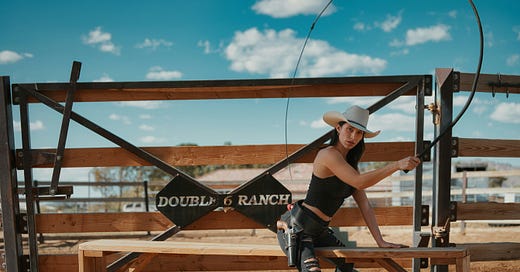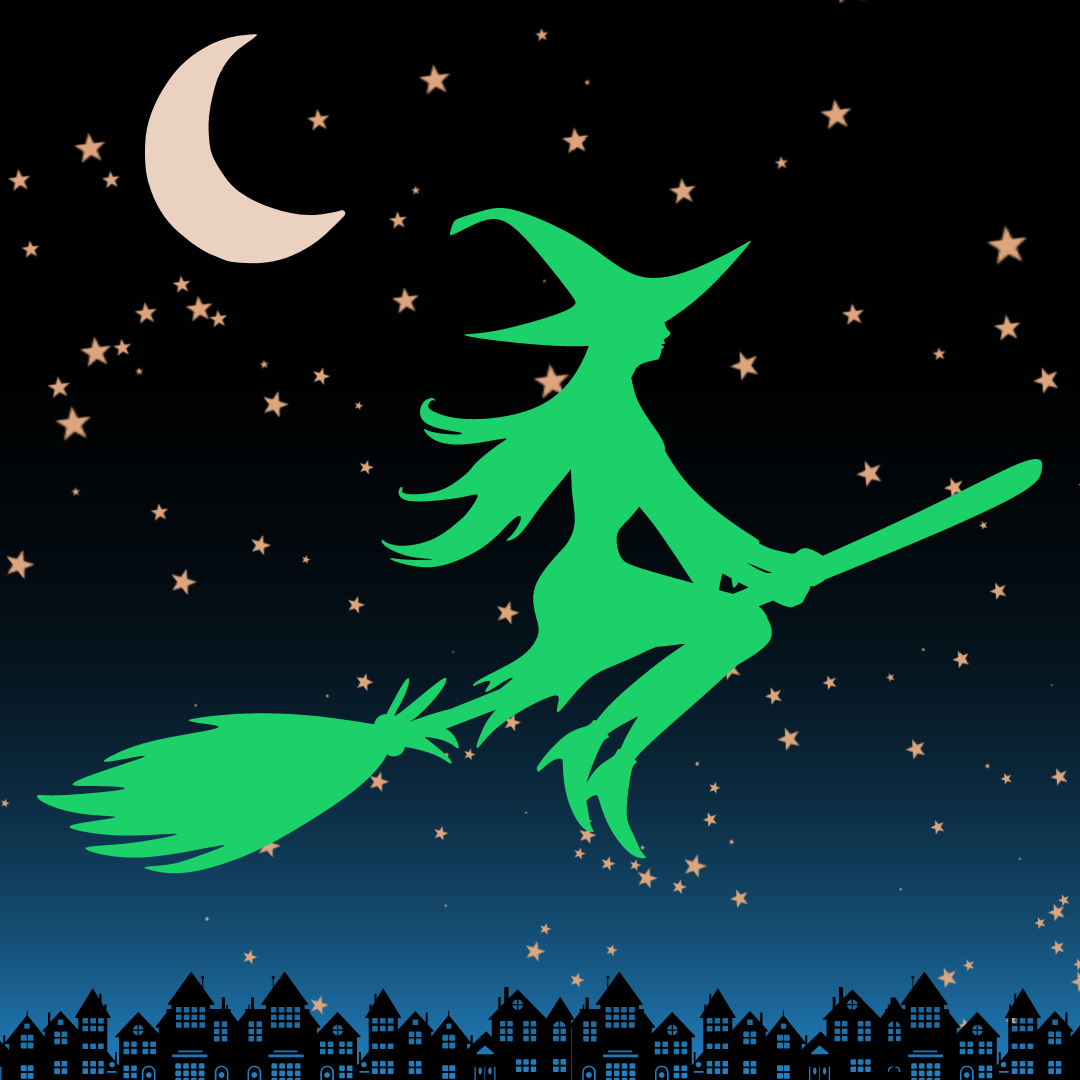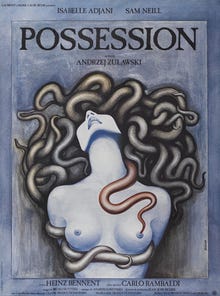*this post contains explicit language and brief mentions of sexual abuse*
SPOILERS AHEAD: American Horror Story: Murder House (2011), Black Mirror (“The National Anthem”), Creep (2014), I Feed Her to the Beast and the Beast is Me by Jamison Shea, Last Tango in Paris (1972), Possession (1981), Starling House by Alix E. Harrow
“I kiss freaks that treat me like an animal.”
I’d been listening to Snow Wife’s popular song “American Horror Show” on repeat last October—now a staple in my Halloween playlist—when this line caught my attention. I can sing along to a song for years without thinking about what the lyrics mean, so it had taken several listens for me to pick up on the fact that the song was about sex.
Hearing that one line instantly transported me back to high school, recalling how T.I rapped “Treat her like an animal/ Somebody call PETA” in Britney Spears’ “Tik Tik Boom.” Upon realizing those lyrics were from a Britney song, I then thought of the snake draped across her shoulders in her iconic “I’m a Slave 4 U” VMA performance. From there, my mind went to Nicki Minaj’s “Anaconda”—in which the constrictor is used as a euphemism for dicks—and the album cover of Cobra Starship’s While the City Sleeps, We Rule the Streets—in which a woman and snake stick out their tongues, the tips nearly touching, reminiscent of Michelangelo’s The Creation of Adam.
Long story short, I started mulling over how frequently we reference animals as sexual objects and fetishize animal cruelty. I then began documenting every instance of this in songs, books, shows, and movies over the next few months. The following list includes just a handful of the ones I thought about or stumbled across since October. Let’s look through them, and on the other side I’ll discuss further why we do this:
Mean Girls (2004)
The antagonist’s mom’s dog bites her nipple, tugging on it like a chew toy
Creep (2014)
The antagonist (Joseph) wears a large wolf mask, nicknamed Peachfuzz, to scare the protagonist; part of this includes doing a weird little dance in which he gyrates his hips for an uncomfortably long time while wearing the mask
Joseph claims to have found animal pornography on his wife’s computer, so he kidnapped and raped her while wearing Peachfuzz
Joseph pretends to fall asleep and mutters “Peachfuzz” with a smile on his face, then begins to masturbate
House of Leaves by Mark Z. Danielewski
The protagonist is infatuated with a stripper who has a tattoo of a rabbit right beside her crotch, calling it “The Happiest Place On Earth” — the allusion to Disney leads the protagonist to call her Thumper
The Cabin in the Woods (2011)
The sexy blonde makes out with a taxidermied wolf head
Black Mirror, “The National Anthem” (2011)
The British Prime Minister is forced to rape a pig
The Wedding Trough (1974)
A Belgian film dubbed “the pig fucking movie” (um, why does Google classify this as horror/romance???)
The Witches of Moonshyne Manor by Bianca Marais
One of the witches likes to ride the fake horses on carousels “because she professes to like something hard between her legs”
Night Shift (2023)
A couple checks into a motel to have some kinky sex; the wife wears a black bird mask
What We Do in the Shadows, “The Finale” (2024)
Vampire Laszlo creates a Frankensteinian monster of reanimated human body parts, who then gets really horny and fucks the large taxidermied bear in their living room
The protagonist (Molly) and her boyfriend (Jeff) do some role-play in the film’s first scene, with her dressed as a dominatrix and him wearing nothing but a turkey-shaped G-string (forgive me if I don’t have the terminology correct—this is new terrain for me)
At the dinner table later, Molly’s mom says suggestively, “I like a man who knows how to handle his turkey.” Jeff jokes, “Well then you should see what I can do with my turkey.”
The protagonist and her husband have their best sex after she accepts the part of herself that turns into a dog
“That weekend, when her husband was home, she wanted it from behind. She wanted him to bite the back of her neck. She wanted to fight and bite, and then she wanted to fuck him hard. She wanted it rough, and then, afterward, she wanted to be patted on the head, to have her hair stroked and straightened, her underneck rubbed, and then her belly rubbed, too…. Afterward, he said, I don’t know what’s gotten into you, but please don’t change.”
Krampus: The Yule Lord by Brom
Krampus, a satyr-like creature, fantasizes about escaping his prison and being celebrated with festivals like he was in the past:
“Then they would parade their plumpest young women before [Krampus], and to the cheers and laughter of all he would mount them, one after another, rutting with them like the beasts in the woods, blessing them with fertile, healthy wombs.”
“And soon, [Krampus] thought, I will be blessing mankind again. But this time it will be these lost peoples of the Virginias. For this new land of America has dire need of me, for me to be great and terrible, to chase away their dark spirits, to beat the wicked amongst them. And I shall, for the Yule Lord knows how to be terrible, and I shall be terrible, and they will come to worship me, lavish me with celebration and feast…and again line up their young women for me to glorify.”
Protagonist Jesse’s ex-wife’s new partner tells Jesse he’s going to have her perform oral sex on him:
“Gonna make her slobber all over my knob. Smack her ass and make her bark and whine.”
Red One (2024)
Santa Claus calls his right-hand man (played by the Rock) the reindeer’s boyfriend
This could be construed as harmless, but the reindeer are all female, which makes it feel a little extra weird. (Since when are the reindeer female? This is not the kind of equal representation I like! Did they change them to lady reindeer specifically to make this joke? If so, why can’t they be the Rock’s “boyfriends”?) Santa exploits them to pull his sleigh, then patronizes them with comments like this.
Last Tango in Paris (1972)
A real rape captured on film, perpetrated by Marlon Brando at the behest of the director, using butter as a lubricant
Thanks to
for writing about this in “Marlon Brando, butter and ecofeminism,” as well as the 1963 Turkish film Dry Summer (Susuz Yaz) in which a male character erotically milks a cow and drinks directly from her udders to seduce a woman
Annie Bot by Sierra Greer
The protagonist is a “Cuddle Bunny,” a live-in robot designed to be intimate with their human owner/partner
Annie’s owner gets turned on when she takes a big bite of hamburger, so she takes another. Then they fuck.
House of Spoils (2024)
The protagonist, a chef, tells her boss, “This filet’s about to look so sexy you gonna leave your wife.” The head chef turns and asks another chef, “Would you fuck this filet, Feder?” who responds, “Oh, hell yeah.”
Babygirl (2024)
A female CEO enters into a dom/sub relationship with a younger man, and he makes her drink a full glass of milk at one point. The image of Nicole Kidman drinking that milk is the trailer’s thumbnail.
Their relationship begins when he calms down a dog that raced up to her. She asked how he did it, and he says he gave the dog a cookie, then asks if she wants one.
The Midnight Feast by Lucy Foley
One of the protagonists laments that the bull on his farm gets more action than he does: “Ivor is the farm’s ancient bull. He’s probably had sex with about a thousand cows, and in the past I’ve thought about how that’s nine hundred and ninety-nine more than my tally.”
Only a thousand? I don’t know much about Lucy Foley’s experience regarding this topic, but it’s very rare for cows to mate naturally on farms, as it takes longer and risks injuring the animals. It’s far more common for bulls to mount an artificial cow and ejaculate into a fake vulva, so the semen can then be extracted, sold, and inseminated into cows by human hands. (More on this later.)
“Closer” by Nine Inch Nails
“I wanna fuck you like an animal”
“You let me violate you/ You let me desecrate you”
Music video for “Whiplash” by Architects
Two people in masks kiss as a rat climbs up the woman’s shoulder
Starling House by Alix E. Harrow
When the love interests finally give in to their desire for one another, the protagonist describes it as “an urgent, animal hunger that swells until it swallows both of us.”
I Feed Her to the Beast and the Beast is Me by Jamison Shea
The protagonist kisses a man who is part-human, part-monster. She describes it as “all-consuming. There was no space left for thinking. It was base, a creature given over to only feeling.”
“Somewhere amid breathless breaks and restless hands, [he] shifted again. Mortal and immortal, he flickered like lightning, antlers sharp and then gone, primeval and powerful, both predator and prey.”
Afterward, she tells him that she doesn’t mind his beastly appearance: “I kinda like it, actually.”
With the examples from Starling House or the first quote from I Feed Her to the Beast and the Beast is Me, the authors are simply describing arousal as an animalistic thing. I don’t have a problem with that. (Actually, I don’t have a problem with most of these examples.) However, it plays into a stereotype that animals are lustful, that they experience a purer form of sexuality, that they have an insatiable “sex drive.”1 (This very idea—animals as hedonistic creatures incapable of rational thought—was used for millennia to deny non-white people, especially Africans and African Americans, basic human rights.) I take umbrage with that, as a person (and animal) who doesn’t feel sexual attraction and could live quite blissfully the rest of my life never having sex. Does that make me less of an animal, less of a person? Can only real animals enjoy the carnal pleasure of fornication?
Becoming the Absent Referent
For a culture so obsessed with sex, sexuality remains taboo. Before realizing I was asexual, I didn’t understand what my “sexual orientation” was. Because our society lumps sexual attraction together with romantic attraction, I was left in an uncomfortable middle ground. I wasn’t gay, but I wasn’t straight either. I knew most of my high school friends had similar reservations about sex, but at what point did my fear of it become immaturity? Was it pathological, some sickness within me? The looming specter of sex plagued my relationships, and with the exception of one, I managed to extricate myself from them before things got that serious.
Seeing women so sexualized in all the shows and movies I watched, in ads on tv, and in the burgeoning realm of social media, I resented them for having that special something I never would. They were sexy and alluring, and I wanted that. Angela Chen shares about that same feeling in Ace: “I craved the thrill of being, specifically, sexually desired. I didn’t experience sexual attraction myself, yet I wanted others to have that desire for me.” If I somehow managed to lure in a boy, I would be a tease, promising them something I could never deliver. I wanted to be desired but ran away whenever I was.
My story isn’t so different from that of many women. Renee Engeln discusses how women’s worth is often tied to their physical appearance in Beauty Sick:
What these two writers fail to discuss is how being a piece of meat objectifies both women and animals. The cover of Carol J. Adams’ The Pornography of Meat features an image of a pin-up girl/hamburger with long, slender legs in high heels, and a speech bubble saying “Eat me.” Adams writes that the term “piece of meat” conveys that “we are only ever on the menu, and never at the table.” To be meat is to be objectified, to turn a living being into something to be observed, judged, and consumed. In both The Pornography of Meat and The Sexual Politics of Meat, she includes images of naked women’s bodies used in advertisements, lines drawn across their skin and labeled as cuts of meat: kneeling, facing away from the observer, “rump” plastered above her bare ass, and head turned in profile. The only purpose is to sexualize both the woman and the meat, though the animals—the cows, pigs, and chickens depicted in real butchering guides—are shown in a neutral standing pose rather than a provocative, submissive position. Women must titillate the male gaze, drawing his eye to each segment of flesh before she can be devoured.
Eating Women
The relationship between sex and consumption is tightly intertwined. A nearly naked woman standing inside a vending machine presses herself against the glass on Asking Alexandria’s From Death to Destiny album cover; I can’t help but wonder if that woman is meant to represent the men’s idea of destiny. Performing oral sex on a woman is colloquially referred to as “eating out,” made even more bestial by vaginas also being called pussies. In her most recent song “What Do Girls Do?” Snow Wife sings, “I could be the appetizer,” and Maroon 5 draws on the wordplay in “Animals”: “Baby, I’m preying on you tonight/ Hunt you down, eat you alive/ Just like animals.”
After Snow Wife claims to “kiss freaks who treat me like an animal,” she sings, “Fuck on me and eat me like a cannibal.” Bringing to mind the monstrous image of cannibals, the eater becomes not an equal partner but a hunter, a killer. Ice Nine Kills’ Dracula-inspired song “Bloodbath & Beyond” employs the double entendre of a “crimson kiss” to this same effect. This vampire drinks a woman’s blood and also eats her pussy. And she wants to be attacked, to be consumed: “You're dripping from the ecstasy of one last crimson kiss/ When the blood pours out like rain/ Take pleasure in the pain/ You're not the only girl to scream my name.” Like the animals in advertisements Carol J. Adams documents in The Pornography of Meat, women submit themselves to the people eating them. To be eaten is to give pleasure to her consumer. They hold all the power over her, and she delights in her body being ingested by another.
Dismembering Women
If we look back to the cover of The Sexual Politics of Meat, we see what Adams calls “dismembering” in practice. Though the woman isn’t being ripped apart limb by limb, her body is chopped into parts to remove the person from the pieces. It’s not just men that do this; women do it to themselves. Renee Engeln reveals in Beauty Sick that women view their bodies in fragments, seeing eyes, nose, neck, breasts, stomach, thighs, toes, etc. as individual parts, whereas men are more likely to see their bodies as a single entity. We dismember ourselves each time we look in the mirror, so it seems natural for others to do the same to us.
As a horror fan, I’m all too used to seeing women objectified. Posters for exploitation films2 of the 70s and 80s often featured drawings of busty women, breasts nearly bursting out of tattered tops, in open-mouthed screams. But in natural horror—which features plants/animals as the monsters—animals become complicit in women’s objectification. You can probably picture the Jaws poster in your mind right now: a naked woman swims freestyle as a giant shark looms beneath, the tip of his head like an arrow pointing at her torso. (The shark is male, of course, even in Peter Benchley’s novel. I wonder if anyone considered that a female shark could also be a cold-blooded ladykiller. I have a feeling that would be considered too sapphic, perpetuating a perverse sort of interspecies heteronormativity.) It’s a great visual, absolutely terrifying. But it places the animal in the role of the voyeur, adopting the male gaze in seeing the woman as a piece of meat.
Jaws is one of the most influential movies ever made, creating the “summer blockbuster” trend, and it spawned a veritable explosion of animal attack horror movies. Those posters replaced the shark with their creature of choice, a trend that continues today.
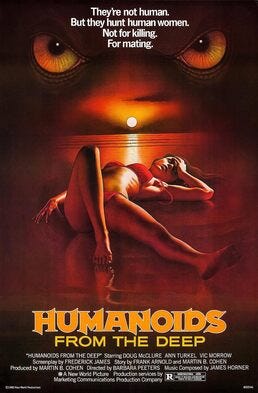
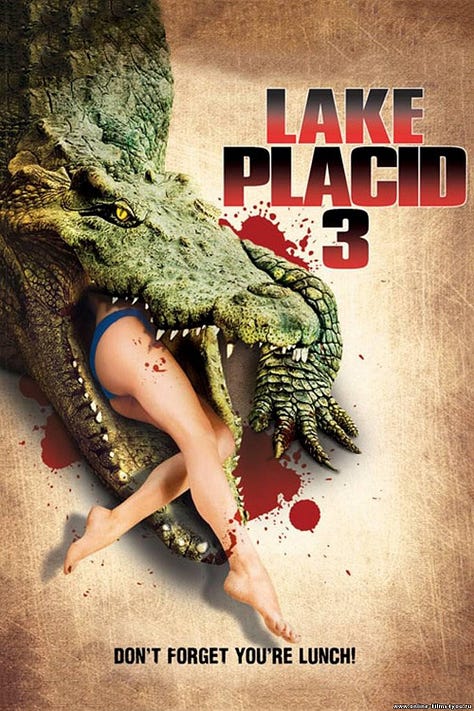
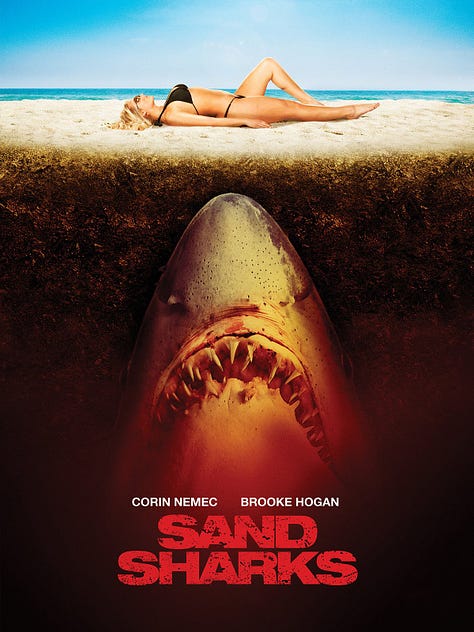

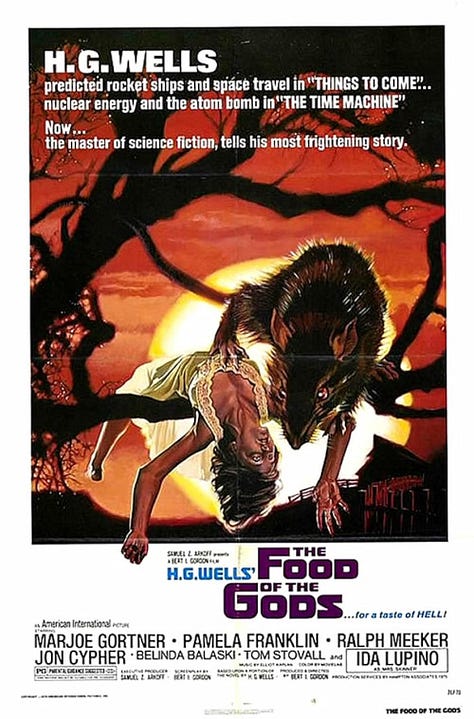
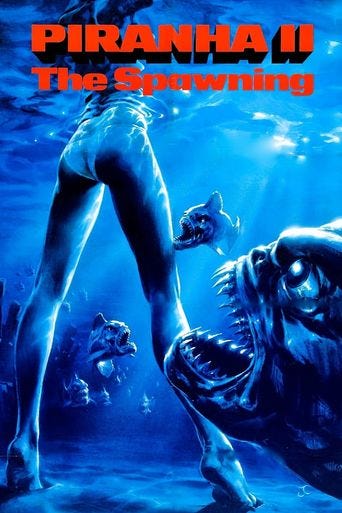
Then there are movies like Possession (1981), in which a woman is bound in tentacles, implying that she is the titular possession. Though there are a few tentacles in the film, this image is egregiously objectifying. With the woman topless and arms bound behind her, she’s forced to bear her breasts for the viewer. Her head tilts back so her eyes aren’t visible, so she can’t watch you ogling her. As if that weren’t enough, a tentacle trails down to her nipple, naturally asking the viewer to lower their gaze. This woman is possessed by some sort of parasitic creature, and the viewer becomes complicit in her exploitation.
As I wrote about when discussing the slasher subgenre, I see animal attack movies as a fusion of natural horror and slashers. Animals take the place of a masked (male) killer, terrorizing women after they’ve thoroughly objectified themselves first. Like Possession, the image on the Lake Placid 3 (2010) poster never occurs in the film. Even as this imaginary woman is being eaten alive, her legs and ass are perfectly posed for the viewer. There’s a certain humiliation in dying so beautifully, as if she isn’t allowed to thrash and bleed and rip her legs to bits as she struggles to escape. No, she will be swallowed willingly and calmly.
It should also be noted that women in this kind of media are nearly always conventionally attractive: white, young, skinny, cisgender, non-disabled. You won’t see a woman with a prosthetic leg or wrinkles, definitely no body hair or stretch marks—that would break the illusion that these women exist so their bodies, or body parts, can be admired.
Reinforcing the Gender Divide
Though it’s far more common for women to be sexualized in this way, men do sometimes get a taste of objectification. K-pop boy group EHYPEN asks their (mostly female) fans, in a very PG way, to “Bite Me” in one of their most popular songs, and the girls sing those words back to the idols. In the seventh episode of American Horror Story: Murder House, the ghost of a young Moira, dressed in a sexy maid outfit, starts taking off a man’s pants and says he’s got the kind of penis “a girl can gnaw on.”3 With dicks also being referred to as weiners, cocks, and meat, consumption is even more directly referenced. Movies like Sausage Party (2016) make this explicit.
“Manhood” is another euphemism for male genitalia, as if that’s all men are. If a dude doesn’t have the appropriate genitals, can he really be considered a man at all?
Snow Wife (in “American Horror Show”) and Britney Spears (in “Circus”) both seek to take on more masculine roles, likening themselves to being ring leaders, a position historically held by men in circuses. Britney’s gonna “crack that whip” as if on an animal. It seems that when women get into a position of power, they lord that power over animals, their inferiors. Objectifying animals just like men have done to them.
Talk Dirty
Gendered, sexualized, and bestial language is pervasive. A sexy man may be called a stud, a term often used for male animals used for breeding. To be sexually aroused is to be horny, both drawing comparisons to horned animals (who can be male or female but are often presumed male) and to erect phalluses. Female foxes are called vixens, a group of mares is a harem. Men may mount and rut with their sexual partner like a beast. New partners experience puppy love, then fuck doggy style. Snow Wife claims to be “a Plan B regular,” so maybe she prefers rawdogging. Ladies straddle their partner in the cowgirl position, and Big & Rich sings that chicks should “Save a Horse (Ride a Cowboy).” Partners may even use light whipping to get a little kinky, tickle their partners with feathers, or dress up in leather harnesses.
“I like when you piss me off,” Snow Wife sings. “Usually means the sex is rough.” TEYA sings for a largely young, male audience in “Bite Marks”—the theme of the 2025 League of Legends season—“I like it when the bite marks cut through the skin.” Like Ice Nine Kills’ lyrics to “take pleasure in the pain,” there’s an understanding that animals must suffer for us, that it’s only through their suffering that humans can retain our dominion. We use their bodies for our pleasure, and we want them to be willing victims.
Femme Men
Feminizing male animals is a common tactic used to minimize their moral worth, and perhaps no industry does this more than dairy. In The Cow with Ear Tag #1389, Kathryn Gillespie recounts her trip to the 2012 World Dairy Expo in which bull semen salesmen blatantly harassed her. After recounting a particularly uncomfortable situation in which a salesman got overly touchy, she writes:
“At several other semen supply and reproductive technology booths, I had a similar experience with men leaning in close to me, confiding in me about the products, touching my shoulder, arm, the small of my back, and making sustained eye contact—qualities of an effective salesperson but with an undertone of something else: a gaze that lingered too long as they looked me up and down—an odd half-smile as they explained enthusiastically, in explicit detail, the reproductive process.”
The industry markets its wares within a strict gender binary, in which bulls are the strong, virile fathers of daughters with large, “youthful mammary systems.” (I don’t think I’ve ever felt so uncomfortable as I am thinking about a father only wanting daughters with big tits.) “An emphasis on the udders and mammary systems as a fetishized trait of commodity production is expressed in…catalog images of cows with engorged udders and tails pushed aside to display prominently the cow’s vulva…. [This] calls up a cultural preoccupation with perky breasts and eternally youthful female bodies—bodies that can maintain an attractive, youthful appearance while at the same time being productive milk-bearing mothers.” These catalogs advertising semen and other reproduction products also depict bulls with “highly visible genitalia.” It’s incredibly rare for human penises and testicles to be objectified, and exploiting bulls’ bodies in this way serves as a means of degrading them to the level of women.
The short-lived Paramount+ show Wolf Pack put me in the unusual position of seeing a man objectified as if he were a woman. The gay teen werewolf ripped his shirt off in nearly every episode, his bare chest often sweaty after exercising as he made out with another guy. The camera lingered on his stomach, showcasing his toned muscles, and I couldn’t help thinking, Someone, please let this boy wear a shirt for goodness’ sake. I’ve wondered how men or teen boys reacted to this, if they felt uncomfortable, if they were comparing their bodies to his. Did they hate themselves after seeing his physique? Did they feel inspired to work out more or to try out some performative homosexuality to see if it would make them more attractive to girls? Did they feel nothing?
Befitting the Animal Kingdom
My relationship to sex is probably different from yours. I feel very much like a scientist, observing the behavior of animals as they engage in various sexual rituals. Oh, you want to put that in there? How curious. And while I have a lot of baggage surrounding sexuality, I also see benefits to the comingling of sexual and animalistic language.
When I read Annie Bot, I was at first a little grossed out when Annie’s owner called her “mouse” before initiating sex. But aren’t pet names kind of sweet? (Maybe I’m projecting, because I’m not sure if there’s anything more complimentary than being compared to a cute little animal.) If nothing else, it helps remind us that we’re also animals. For all we try to distance ourselves from the animal kingdom, we can’t seem to shake our animal roots. There’s nothing inherently wrong in calling on our primal nature when describing or experiencing lust. That’s just part of being a human animal.
On my mind: The Ornithologist’s Field Guide to Love by India Holton
I’m actually a little sad to finally release this post. I’ve been working on it for such a long time that I feel a little lost now that it’s finished. However, India Holton’s delightful romcom helped me feel a little better. I even laughed out loud a few times while reading—quite a feat! Set in 1890, two rival ornithology professors fall in love as they partake in a contest to capture a magical bird. But these two lovebirds are more interested in the birds themselves than their thaumaturgic—a word used so often that I finally learned its meaning—properties. Having read quite a bit about animal welfare in the Victorian era, the protagonists’ progressive views seem a bit anachronistic, but I’m not complaining. Highly recommend!
There’s no such thing as a sex drive. A drive applies only to those functions necessary to survival, e.g., eating, breathing. You can’t die from not having sex.
“Exploitation” here refers to exploiting a trend. Jaws was popular, so movies like Orca, Mako: The Jaws of Death, and Piranha sought to cash in on that.
Women are often infantilized by being referred to as girls, a fixation on youth and virginity as being more sexually desirable. Nowhere is this clearer to me than in K-pop, in which girl groups are required to be like “sexy babies,” as I think of them. They dress in tight, small clothing—crop tops and mini skirts—revealing lots of skin, yet are expected to act innocent, even childlike in interviews. This is epitomized in aegyo, or acting like a baby. The idols do a baby voice and scrunch up their faces to look extra cutesy. Boy groups do this too, and their dancing can be provocative as well. (My favorite group is a boy group, but their choreography more often focuses on dynamic, powerful movements rather than the hip swishing and hand gestures that are more common with girl groups.) Yet the men are nearly always fully clothed. Getting a glimpse of a bare shoulder is enough to give stans heart palpitations. (I may or may not be speaking from experience. Anyhow…)


